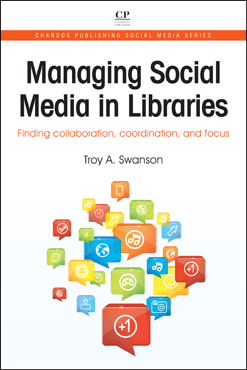 Dr. Troy Swanson’s post this morning has resonated with me. I have an assignment in the Hyperlinked Library course on creating a emerging technology plan or social media guidelines statement. Troy’s ideas fit well but also make me realize that so much is tied up in organizational mindset. Things move and change according to the climate at hand. Maybe part of the assignment should focus on less-tangible, less-predictible things. How can we plan for what we do not know to plan for?
Dr. Troy Swanson’s post this morning has resonated with me. I have an assignment in the Hyperlinked Library course on creating a emerging technology plan or social media guidelines statement. Troy’s ideas fit well but also make me realize that so much is tied up in organizational mindset. Things move and change according to the climate at hand. Maybe part of the assignment should focus on less-tangible, less-predictible things. How can we plan for what we do not know to plan for?
This passage is the heart of Troy’s well-reasoned argument:
This isn’t to say that effective use of social media relies on anarchy. Far from it. Organizations still need a structure around social media. Organizations can encourage social media by defining policies, workflows, guidelines, and best practices. These broad documents offer an outline where experimentation and play can exist around social media tool. The goal is to create a safe environment to play around with social media. Unfortunately, plans often fit our organizational DNA better than playfulness. Plans feel better than experiments, because plans require us to come up with outcomes in advance. Thus, we’ll spend six months developing a plan instead of spending that time developing an online services that advances our mission.
“The book you are holding is a reflection and critical analysis of the use of social media in libraries that rises above and beyond the typical tool of the month style tomes and provides something much more important: a detailed analysis of the whys of social media and the hows of getting staff and library users involved.
Let the technology fall away and what is left is a guide to facilitating and encouraging conversations – a way to tell a story. “Storytelling is a powerful tool,” Troy writes, “and social media represent a way to extend our own stories.” Moving the story beyond the physical place of the library so it exists online to be accessed and enhanced with multiple voices should be the goal of every information organization.
The road is best traveled with a thoughtful and experienced guide. Many helpful voices are found online, blogging, podcasting and Facebooking. Troy has synthesized and collected his own ongoing critical thinking and extensive experience with this work. Among the questions he explores are how to involve staff in sharing the library’s story? Should individual librarians connect with individual users? How can a social media guidelines guide the use of the tools in an evolving and unrestricted manner?
He also addresses the challenges that occur as libraries shift some focus to emerging technologies. Many of these challenges are people-focused, not issues with the technologies themselves. “The challenge around effective social media implementation is get library staff to see social media as an integral part of their jobs so that they choose to participate.” This challenge can be solved with transparency and a clearly defined, yet evolving mission: “If people are fearful of participation or do not see the value of participation, they will not participate.”
Troy writes: “Libraries that have not dabbled in social media may wonder where they should start. The answer may sound straight out of 2004, but it remains true: start a good blog. Blogs remain the most flexible social media tool.” I’ve written extensively about blogging and published my own research on the perceptions and experience of the LIS blogger. I wholeheartedly agree that the blog as platform can be a powerful content management system for telling your library’s story. Combine that tool and the others explored in this work with Dr. Swanson’s insights and critically-focused big picture thinking, and you have a solid path toward engaging your community and encouraging the heart of the user.”
